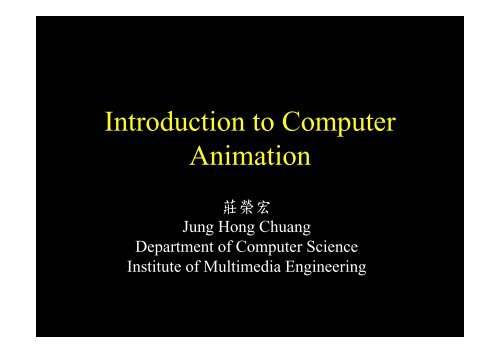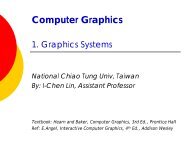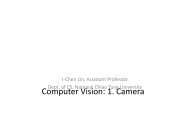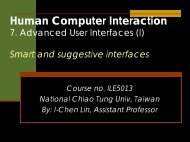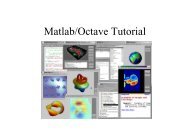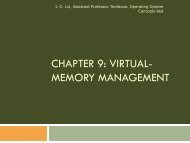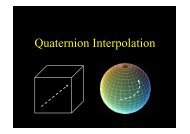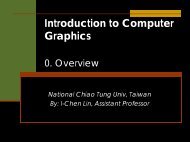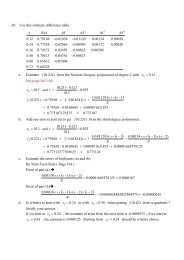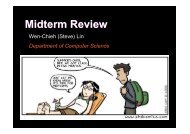Introduction to Computer Animation - CAIG Lab
Introduction to Computer Animation - CAIG Lab
Introduction to Computer Animation - CAIG Lab
You also want an ePaper? Increase the reach of your titles
YUMPU automatically turns print PDFs into web optimized ePapers that Google loves.
<strong>Introduction</strong> <strong>to</strong> <strong>Computer</strong> p<br />
<strong>Animation</strong><br />
莊榮宏<br />
Jung Hong Chuang<br />
Department of <strong>Computer</strong> Science<br />
Institute of Multimedia Engineering
� Administration<br />
�� Course overview<br />
<strong>Animation</strong>, Syllabus<br />
<strong>Introduction</strong><br />
2
Administration<br />
� Course web: http://caig.cs.nctu.edu.tw/course/ICA<br />
� Cl Class lab: l b 資工系計中 EC C 314<br />
� TA: 彭任右, EC 229B, alvin@caig.cs.nctu.edu.tw<br />
� Textbook: <strong>Computer</strong> <strong>Animation</strong>, 2 nd ed., Rick Parent<br />
�� References (papers from major conferences/journals):<br />
� SIGGRAPH<br />
�� Symposium on <strong>Computer</strong> <strong>Animation</strong> (SCA)<br />
� Eurographics<br />
�� ACM Trans Trans. on Graphics<br />
� Office hours<br />
� EC525, Monday d GH, or bby appointment i<br />
<strong>Animation</strong>, Syllabus<br />
3
� Perquisites<br />
Administration<br />
� <strong>Computer</strong> Graphics or equivalent<br />
� 3 Programming assignments (40%)<br />
� Midterm (15%); Final (15%)<br />
�� Term project (30%)<br />
� 2 students/team<br />
� PProposal ld due around dmid idM March h<br />
� Forming your team and deciding your <strong>to</strong>pic soon!<br />
<strong>Animation</strong>, Syllabus<br />
4
� Late policies<br />
Administration<br />
� Turn in by 11:59 PM of the due date<br />
� Penalty of late submission of assignment<br />
�� 10% of the value of the assignment per day<br />
� No late submission is allowed for the term project<br />
� Cheating policies<br />
� 0 points for any cheating found on<br />
assignments/project or test<br />
<strong>Animation</strong>, Syllabus<br />
5
What is this course about?<br />
� This is not a course <strong>to</strong> teach you Maya, 3D<br />
Studio Max, , or other animation softwares.<br />
� But you will learn some basic operations of 3ds<br />
Max<br />
� This is a course <strong>to</strong> teach you computer<br />
algorithms l i h and d techniques h i for f making ki<br />
computer animation.<br />
� You will need <strong>to</strong> get your hands dirty!<br />
<strong>Animation</strong>, Syllabus<br />
6
Course overview<br />
� <strong>Introduction</strong> <strong>to</strong> computer animation<br />
�� Technical background for computer animation<br />
� <strong>Introduction</strong> <strong>to</strong> computer animation software<br />
� Interpolation and Basic Techniques<br />
�� Skeletal animation (Motion capture)<br />
� Physics-based animation<br />
� Group behavior and crowed animation<br />
�� Other <strong>to</strong>pics<br />
<strong>Animation</strong>, Syllabus<br />
7
<strong>Introduction</strong> <strong>to</strong> computer animation<br />
� His<strong>to</strong>ry of animation<br />
�� <strong>Animation</strong> production<br />
� Demos<br />
<strong>Animation</strong>, Syllabus<br />
8
� Transformation<br />
Technical background<br />
�� Differential equation basics<br />
� Au<strong>to</strong>matic Camera Control<br />
<strong>Animation</strong>, Syllabus<br />
9
Interpolation and Basic Techniques<br />
� Controlling the Motion Along a Curve<br />
�� Interpolation of Rotations Represented by<br />
Quaternions<br />
� Path Following<br />
� Key-Frame Key Frame Systems<br />
� Deforming Objects<br />
� Morphing (2D)<br />
�� 3D Shape Interpolation<br />
<strong>Animation</strong>, Syllabus<br />
10
� 3D orientation<br />
�� Forward kinematics<br />
� Inverse kinematics<br />
Skeletal animation<br />
� Motion capture technology<br />
�� Motion editing<br />
<strong>Animation</strong>, Syllabus<br />
11
Physics-Based Physics Based animation<br />
� Rigid body simulation<br />
�� Collision detection and contact<br />
� Skin deformation and cloth simulation<br />
� Hair/fur simulation<br />
�� Deformable object simulation<br />
� Fluid simulation<br />
<strong>Animation</strong>, Syllabus<br />
12
Group behavior and crowed animation<br />
� Particle systems<br />
�� Flocking behavior<br />
<strong>Animation</strong>, Syllabus<br />
13
Principles of Traditional <strong>Animation</strong><br />
Thomas & Johnson,<br />
“The Illusion of Life:<br />
Disney <strong>Animation</strong>”<br />
<strong>Animation</strong>, Syllabus<br />
14
<strong>Animation</strong>, Syllabus<br />
S<strong>to</strong>ryboarding<br />
From “Toy S<strong>to</strong>ry”, http://www.pixar.com/featurefilms/ts/<br />
15
<strong>Animation</strong>, Syllabus<br />
<strong>Computer</strong>-assisted <strong>Computer</strong> assisted <strong>Animation</strong><br />
MMaking ki of f Toy T S<strong>to</strong>ry St<br />
16
<strong>Animation</strong>, Syllabus<br />
Toy S<strong>to</strong>ry<br />
17
� Live action recording<br />
Motion Capture<br />
� track motion of reference points<br />
� convert <strong>to</strong> joint j angles g <strong>to</strong> drive an articulated 3D<br />
model<br />
�� drive a deformable surface<br />
Motion Analysis<br />
<strong>Animation</strong>, Syllabus<br />
Polar Express<br />
18
I, Robot<br />
<strong>Animation</strong>, Syllabus<br />
Motion Capture<br />
19
Motion Analysis<br />
<strong>Animation</strong>, Syllabus<br />
Motion Capture<br />
20
Facial Motion Capture<br />
Pirates of the Caribbean: Dead Man’s Chest<br />
<strong>Animation</strong>, Syllabus<br />
21
Physics-based Physics based <strong>Animation</strong><br />
� Generate motion based on physical laws (e.g.,<br />
New<strong>to</strong>n’s laws, Fluid dynamics)<br />
� Simulated physical phenomena<br />
� gravity g y<br />
� momentum<br />
� collision<br />
� friction<br />
� fluid flow (liquid, gas, turbulence)<br />
� flexibility, elasticity<br />
�� fracture<br />
<strong>Animation</strong>, Syllabus<br />
22
<strong>Animation</strong>, Syllabus<br />
Simulated Flames<br />
Duc Quang Nguyen Nguyen, Ronald Fedkiw and Henrik Wann Jensen, Jensen<br />
SIGGRAPH 2003<br />
23
Simulated Water<br />
Nick Foster and Ronald Fedkiw, SIGGRAPH 2001<br />
<strong>Animation</strong>, Syllabus<br />
24
Simulated Water<br />
Nick Foster and Ronald Fedkiw, SIGGRAPH 2001<br />
<strong>Animation</strong>, Syllabus<br />
25
Simulated Water in Films<br />
� Antz water simulation, similar techniques were<br />
used in Shrek (Nick ( Foster & Ronald Fedkiw) )<br />
<strong>Animation</strong>, Syllabus<br />
26
<strong>Animation</strong>, Syllabus<br />
Simulated Water in Films<br />
27
Simulated Cloth<br />
Kwang-Jin Choi and Hyeong-Seok Ko, SIGGRAPH 2002<br />
<strong>Animation</strong>, Syllabus<br />
28
Star Wars<br />
<strong>Animation</strong>, Syllabus<br />
Simulated Cloth in Films<br />
Stuart Little<br />
29
<strong>Animation</strong>, Syllabus<br />
Simulated Deformable Object<br />
Doug James & Dinesh Pai Pai, SIGGRAPH 2002<br />
30
<strong>Animation</strong>, Syllabus<br />
Group Behavior<br />
Mulan (1998)<br />
31
<strong>Animation</strong>, Syllabus<br />
Questions?<br />
32


